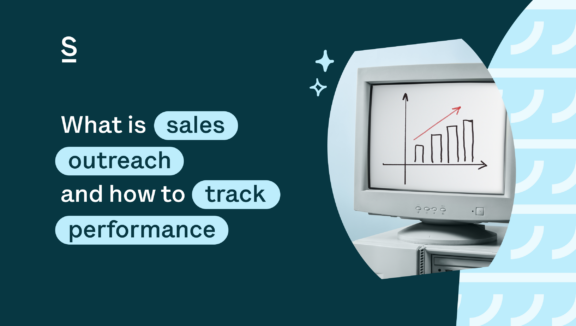What is outreach in sales and how to track performance

When you ask, “What is outreach?” the answer is about far more than just contacting leads and prospects. It’s a strategic effort to reach potential clients and partners, offering value and fostering relationships that drive business growth.
Understanding the answer to the question, “What is outreach”, understanding the impact of your outreach, and tracking the performance of these outreach initiatives is key to refining strategies, ensuring every interaction counts and contributes meaningfully to your sales objectives.
Key highlights
- What is outreach?
- What is outreach important for in sales?
- Tools for sales outreach: Salesloft and Outreach Chrome Extensions
- Personalizing Sales Outreach with LinkedIn Message Templates
- Tracking and measuring sales outreach performance
What is outreach?
Let’s start with the basics: What is outreach? Outreach is a term that encapsulates a range of activities designed to initiate and nurture relationships with potential clients or customers. But what is outreach exactly? Simply put, outreach is the act of reaching out to potential customers. It’s about creating avenues to introduce your product or service to the market, with the aim of building a lasting connection. This could mean reaching out to potential customers through emails, calls, social media, or even face-to-face interactions at events or conferences.
Different outreach strategies cater to various business needs. For instance, cold emailing or calling involves reaching out to potential leads with no prior contact. This method is particularly effective in generating new leads but requires a well-crafted approach to capture interest.
Then there’s networking – an outreach strategy that leverages existing relationships and connections to create new business opportunities. Social media outreach is another strategy, harnessing the power of platforms like LinkedIn to connect with and engage potential clients in a more informal, yet professional setting.
Each of these strategies has its unique advantages and challenges. The key lies in understanding your target audience and choosing the method that best aligns with their preferences and behaviors. For a B2B company, LinkedIn outreach might be more effective, while a consumer-focused brand might find more success with other social media or email campaigns. The versatility of outreach allows businesses to adapt their strategies to meet their specific goals and the expectations of their audience.

Learn how to maximize your sales outreach
Learn how to maximize your sales outreach by staying ahead of evolving market demands and technological advancements with the right tools.
What is outreach important for in sales?
The strategic importance of outreach lies in its ability to create opportunities, generate leads, and build brand awareness in a targeted and efficient way.
Consider a scenario where a sales team leverages outreach to connect with potential clients. By carefully crafting messages that resonate with their audience’s needs and interests, they can pique interest and open the door to further discussions. This is a classic example of successful outreach in action – converting cold contacts into warm leads, and eventually, into loyal customers.
Effective outreach also plays a crucial role in positioning a company as a thought leader in its industry. By sharing valuable content and insights, a business can establish credibility and trust, two key ingredients in the recipe for sales success. It’s not just about selling a product or service; it’s about providing value and building relationships that last.
- Understanding exactly what is outreach allows businesses to stay ahead of the curve, adapt to market changes, and maintain a connection with their audience.
- By integrating outreach into their sales strategy, companies can ensure they are not just reaching out to potential clients but are building a foundation for long-term success and growth.
Tools for sales outreach: Salesloft and Outreach Chrome extensions
Outreach requires not just strategy, but also the right tools. Two standout solutions in this regard are the Salesloft and Outreach Chrome Extensions. These tools are revolutionizing the way sales teams interact with prospects, particularly on platforms like LinkedIn.
Salesloft and Outreach are tools for centralizing your outreach. They enable sales teams to automate emails and personalize messaging based on many criteria or triggers. Surfe brings these Salesloft and Outreach to LinkedIn with the Surfe Chrome extension and helps to significantly increase sales growth.
They ensure that every lead is properly nurtured and moved through the sales funnel efficiently.
“Previously it took at least 15 minutes to put a prospect from LinkedIn to SalesLoft while also recording it on Salesforce. Now, with Surfe, it takes ⅓ of the time and I don’t have to leave LinkedIn.” -Axel, Business Operations Manager at Batch
Salesloft and Outreach enable the outreach process itself to become more strategic and targeted. Sales teams can identify key decision-makers within organizations, understand their needs, and tailor their outreach accordingly. The ability to quickly add new contacts and sync them with the CRM means that no opportunity is missed.

Connect Outreach or Salesloft to LinkedIn
Send contacts to Outreach or Salesloft directly from their LinkedIn profiles. No tab-switching. Everything backed to the CRM in real time.
Personalizing sales outreach with LinkedIn message templates
What is outreach good for in terms of personalization? Where generic messages are often ignored, personalizing communication can make a significant difference in engagement and response rates. This is where Surfe’s LinkedIn message templates come into play, offering a powerful tool for personalizing outreach in a scalable way.
Surfe’s message templates are designed to transform the way sales teams approach LinkedIn outreach. These templates are not just pre-written messages; they are carefully crafted to be easily customizable, allowing sales reps to add a personal touch to each interaction. By incorporating specific details about the prospect or their company, sales reps can show that they’ve done their homework and are genuinely interested in providing value.
The use of personalized LinkedIn message templates can dramatically increase reply rates. Prospects are more likely to respond to a message that resonates with their specific needs and interests. Personalization creates a sense of relevance and shows that the sender has taken the time to understand the recipient’s unique challenges and goals.
But personalization isn’t just about using the prospect’s name or mentioning their company. It’s about tailoring the message to address their specific pain points, interests, and objectives. Surfe’s templates are designed with this in mind, offering a variety of templates that can be adapted to different situations and prospects. Whether it’s reaching out to a new contact, following up on a previous conversation, or sharing relevant content, there’s a template that can be customized to fit the context.
Strategies for maximizing reply rates go beyond just the content of the message. Timing is also critical. Understanding the best times to send messages, based on the prospect’s timezone and typical online hours, can increase the chances of your message being seen and responded to. Additionally, following up on messages in a timely manner, while being mindful not to be too pushy, is essential in keeping the conversation going and building a relationship.

Learn how this message template tool increases your reply rate
This free tool lets you use LinkedIn Message Templates that increase your reply rate, reduce the copy and pasting, and automatically add variables.
Organizing sales outreach
Effective organization is pivotal to the success of sales outreach. It’s not just about reaching out to prospects; it’s about doing so in a structured, strategic way that maximizes efficiency and results. This is where the integration of CRM and LinkedIn plays a crucial role. By harmonizing these tools, sales teams can streamline their outreach processes, ensuring that every interaction is tracked, analyzed, and optimized for success.
The first step in organizing sales outreach is leveraging the CRM system as a central hub for all sales activities. A CRM not only stores contact information but also tracks every interaction with each prospect. This includes emails sent, calls made, meetings scheduled, and responses received. By having all this information in one place, sales teams can create a comprehensive view of each prospect, understand their journey, and tailor future interactions accordingly.
Integrating LinkedIn with the CRM takes this a step further. With tools like Surfe, sales reps can directly add LinkedIn contacts to their CRM with a single click. This seamless integration ensures that no valuable contact or interaction is lost. It also allows sales teams to sync LinkedIn conversations directly to the CRM, providing a richer, more complete view of each prospect’s preferences and behaviors.
Organizing outreach also involves segmenting your audience and tailoring your approach to each segment. Different prospects have different needs and respond to different types of outreach. By segmenting your CRM data, you can customize your outreach efforts to be more relevant and effective for each group. This might involve varying the messaging, the communication channels used, or the timing of your outreach.
Finally, effective organization of sales outreach requires regular review and optimization. Sales teams should continuously analyze the data from their CRM and LinkedIn interactions to identify what’s working and what’s not. This might involve A/B testing different outreach strategies, refining the messaging, or adjusting the target audience segments.
In summary, organizing sales outreach effectively hinges on the integration of CRM and LinkedIn, segmenting your audience, and continuously optimizing your strategies. By doing so, sales teams can ensure their outreach efforts are as effective and efficient as possible.
Tracking and measuring sales outreach performance
What gets measured gets managed. What is outreach managing? Performance. So tracking and measuring the performance of sales outreach is critical to understanding its effectiveness and making informed decisions for future strategies. This is where key metrics come into play, offering valuable insights into the impact of outreach efforts.
One of the primary metrics to track is response rate. This metric measures the percentage of outreach efforts that receive a response from prospects. It’s a direct indicator of how well your messaging resonates with your target audience. A low response rate might indicate a need to refine your messaging or target a different audience.
Another important metric is conversion rate, which measures the percentage of prospects who take a desired action after an outreach attempt, such as scheduling a demo or making a purchase. This metric helps gauge the effectiveness of your outreach in moving prospects through the sales funnel.
Engagement metrics are also crucial. These include metrics like open rates for emails, click-through rates for links shared, and interaction rates on social media posts. High engagement rates suggest that your content is relevant and compelling to your audience.
The use of a CRM plays a vital role in tracking these metrics. By integrating with tools like LinkedIn and email platforms, CRMs can provide a comprehensive view of how your outreach strategies are performing across different channels.
A data-driven approach to outreach is essential for continuous improvement. By regularly reviewing performance metrics, sales teams can identify trends, understand what resonates with their audience, and adjust their strategies accordingly. This could involve tweaking the messaging, experimenting with different outreach channels, or targeting different segments of your audience.

Level-up your outreach with Surfe
Try it for free. No tab-switching. Everything backed to the CRM in real time. Why not?
Let’s wrap it up!
Understanding the question of what is outreach is a cornerstone of success in today’s competitive business environment. From defining what outreach is to leveraging cutting-edge tools like Salesloft and Outreach Chrome Extensions, and personalizing communication with LinkedIn message templates, each aspect plays a vital role in crafting an effective sales strategy.
Organizing and tracking outreach efforts through CRM integration and data-driven approaches further enhances the ability to connect meaningfully with prospects.
Remember, it’s not just about reaching out; it’s about making every interaction count.


